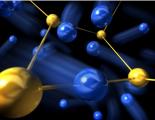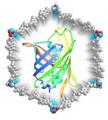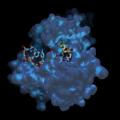A study, recently published in PLoS ONE by researchers from Cornell University, Hospital for Special Surgery, and SSRL, describes nanoscale visualization of micro-damage in cortical bone tissue using x-ray negative staining and synchrotron-based x-ray imaging. The first study to examine bone damage at the nanoscale using full-field x-ray imaging in cortical bone, it provides new insights into bone damage and propagation of fractures.
Approximately 1,700 scientists visit SSRL annually to conduct experiments in broad disciplines including life sciences, materials, environmental science, and accelerator physics. Science highlights featured here and in our monthly newsletter, Headlines, increase the visibility of user science as well as the important contribution of SSRL in facilitating basic and applied scientific research. Many of these scientific highlights have been included in reports to funding agencies and have been picked up by other media. Users are strongly encouraged to contact us when exciting results are about to be published. We can work with users and the SLAC Office of Communication to develop the story and to communicate user research findings to a much broader audience. Visit SSRL Publications for a list of the hundreds of SSRL-related scientific papers published annually. Contact us to add your most recent publications to this collection.
For the first time, ultrafast x-ray scattering and spectroscopic measurements carried out at SSRL, the Advanced Light Source (ALS) and the Advanced Photon Source (APS) captured the atomic-level dynamics of a superionic nanocrystal as it transformed.
An international collaboration of scientists, including several from SSRL, has taken advantage of the broad range of photon science capabilities available at the lab to investigate a proposal that adsorption and desorption of a molecule to a surface – both fundamental processes of interfacial chemistry – proceed through a transient “precursor” state in which the molecule is weakly bound to the surface.
As part of a larger, DOE-funded investigation into bioremediation of uranium in contaminated aquifers, a group of SSRL scientists made a surprising discovery about how uranium ions behave in the environment. In addition to overturning current scientific models, this research will lead to more efficient, less costly methods for uranium cleanup and mining.
Recently, scientists at the University of California, Berkeley and Lawrence Berkeley National Laboratory and their collaborators synthesized a series of metal-organic frameworks (MOFs) with pores up to 98 Å in diameter—large enough to house protein molecules. For the first time the researchers were able to design strategies to overcome three major obstacles to increasing pore capacity...
The global production of engineered nanoparticles (ENPs) is currently a trillion-dollar industry. However, ENPs behave differently than their bulk counterparts, mostly due to increased specific surface area and reactivity, which has raised concerns about their fate, transport, and toxicity in the environment. A growing number of products containing ENPs are already on the market, including ZnO nanoparticles widely used sunscreen, gas sensors, pigments and other applications, and nanoceria (Ce ENPs) used as catalysts for internal combustion and oil cracking processes. The potential storage of these ENPs or their biotransformed products in edible/reproductive organs of crop plants can allow them to enter the food chain and the next plant generation.
Doping graphene with small amounts of another element such as nitrogen or boron enables scientists to "tune" its properties to make it more suitable for a variety of applications, such as contact material in solar cells. Determining the chemically distinct species and different bond types that result from of doping monolayer graphene – even sub-percent-level doping –can be done using the high energy resolution and tunable polarization and energy of synchrotron light such as provided by SSRL.
Of the 11 species of Neisseria bacteria that colonize humans, 9 of them coexist peacefully with us. However, two can cause serious diseases N. gonorrhoeae, responsible for the sexually transmitted disease gonorrhea, and N. meningitidis, which causes septicemia and meningitis. Commercially available vaccines exist for four of the five known disease-causing serogroups of N. meningitidis (A, B, C, Y, W135) but no vaccine exists to combat serogroup B (menB); nor is there a vaccine available against N. gonorrhoeae. One target for vaccine development against menB and N. gonorrhoeae is the iron transporters found on the pathogens’ surfaces. Cut off their access to iron and these pathogens cannot survive.
Lassa virus is endemic in Western Africa, and is the most common cause of viral hemorrhagic fever, infecting an estimated 300,000-500,000 people annually. It is also the hemorrhagic fever most frequently transported out of Africa to the United States and Europe. Understanding the key proteins of Lassa virus and any Achilles’ Heels written into their protein structures will enable development of therapeutics for medical defense. Recent analysis of the crystal structure of the virus’ RNA binding domain done at SSRL may have revealed one promising area of vulnerability.
Although the behavior of conventional superconductors has been explained via the BCS theory, the mechanism of superconductivity in the cuprate high temperature superconductors remains unresolved. One approach to this problem is to explore the phases next to superconductivity on the temperature-doping phase diagram. The pseudogap phase above Tc has been a particular stumbling block because it is not a Fermi liquid as with conventional superconductors.
There has been increasing evidence that the pseudogap phase is distinct from superconductivity and persists below Tc, and not simply a precursor to superconductivity. In a study recently published in PNAS, researchers at SSRL Beam Line 5-4 and Stanford explored the full doping, temperature, and momentum dependence of spectral gaps in the superconducting state of Bi2Sr2CaCu2O8+δ (Bi-2212) with unprecedented precision and completeness.














